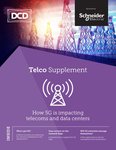It’s commonly accepted that we’re ata crossroads where the decisions we make today will not only shape future generations, but our entire planet. This has become particularly apparent in the global response to climate change, and as sustainability climbs up the corporate and consumer agendas, we see many organizations using green initiatives to drive positive changes that benefit of the world in which we live.
As the insatiable appetite for digital transformation increases, it’s incumbent upon the world’s most influential sectors – from agriculture to buildings and construction, to data centers, IT, energy and utilities – to make a unanimous decision to do so with sustainability at the forefront of their strategies.
Technology has of course become a key enabler for both businesses and consumers alike, and throughout 2020, dependency on digital infrastructure has increased dramatically. In fact by 2035, Schneider Electric estimates that all IT will consume 8.5 percent of global electricity – compared to 5 percent in 2021 – and data centers are expected to take up a large share of this demand. Yet the data center industry is becoming increasingly accountable and has a key role to play in driving sustainable operations, directly contributing towards 5 of the UN’s sustainable development goals (SDGs).
Sustainability and the data center sector
Many of today’s data center operators, from hyperscalers to cloud and colocation service providers, have already led the market by example, and publicly declared ambitious commitments towards Net Zero, adopting more sustainable approaches to digital business.
Microsoft, for example, has started transitioning to using renewable wind energy – a trend that will likely only continue to increase as awareness and demands for renewables from end-users and governments surge.
In fact, this is no truer than in the colocation sector and a recent survey of more than 800 global data center operators by Schneider Electric and 451 Research found that 97 percent of providers’ customers are asking for contractual sustainability commitments, and that their requirements account among the top drivers for sustainability, around 50 percent.
However, meeting increased demand for sustainable practices with vast, obtainable environmental goals that can be put into action requires our sector to work together – no longer can businesses work in silo.
For many, incorporating sustainability into their practices is easier said than done, yet by driving awareness, creating the right strategies and using the right incentives we can encourage the industry to build efficient data centers with sustainability embedded right at the start. Something which will be essential for colocation service providers to remain competitive as more customers base their decision making on working with those organizations who have a green agenda.
A four-stage plan to overcome the climate challenge
The ideal of true data center sustainability is not as complex as it sounds, and in many respects, establishing a comprehensive strategy requires operators to focus on a number of aspects. This includes the data centers design, its location, power utility and both its operational and energy management strategies. So how can data center operators consider, begin to start, or revise their sustainability plans?
This concept is something I was recently invited to discuss during the opening keynote at DCD Europe Virtual, and at the initial stage there are three fundamental components to consider.
Firstly, one must identify a partner with the expertise to help them take sustainable action; secondly, they should evaluate their assets to make decisions on how they can maximize the efficiency of their complete portfolio; and thirdly, they should consider new data center designs or concepts that meet sustainability and efficiency goals – those that can be applied to new projects, or used to retrofit existing facilities.
For many these three concepts are not new or breakthrough ideas, but essential principles that both underpin and help to establish a comprehensive, four-stage sustainability plan that can help operators to overcome the climate challenge. The key steps are:
- Define success for your organization and empower your team to help you achieve it.
- Set targets no matter how large or small and make small gains wherever possible – 1 percent annually over 25 years will make a significant impact in a global organization.
- Deploy programs throughout your business and analyse where improvements can be made on a monthly, quarterly or annual basis.
- Sustain your results by monitoring, managing and sharing the lessons learned.
The business drivers for sustainability
Today there are many organizations that with the help of Schneider Electric, have made significant improvements in their sustainability programs and reaped the long-term rewards. Equinix’s Global renewable energy procurement, for example, has increased from 30 percent to 82 percent within the last three years, while provisioning 100 percent renewable energy in North America has afforded them $23.2M cost savings.
In Europe, 75 percent of Iron Mountain’s electricity has been converted to green power while 100 percent renewable energy serves their entire U.K., Ireland, and Benelux operations. Not only does this save money and reduce their carbon footprint, but also generates enough clean energy to power the equivalent of 56,000 homes – removing more than 10,000 cars from the road annually.
This focus on Net Zero and sustainability is also something that resonates with us strongly at Schneider Electric. We have declared ways to step-up our commitment to carbon neutrality. They include accelerating our 2030 goal of carbon neutrality by five years to 2025; Net-zero operational emissions by 2030 as part of validated SBT target; and achieving a net-zero supply chain by 2050. Furthermore, we have committed to reducing the use of SF6 by end of 2025, this includes within our data center switchgear.
With many countries now signed up to the Paris Agreement, there’s a lot to do and little time to do it in. But one thing we’ve seen is that businesses, especially within the data center sector want to take action and want to do so in unison; using digitization, electrification and collaboration to save people, the planet and to drive cost savings. These aren’t unattainable goals and can be accomplished with a simple formula: renewable energy + electrification x efficiency = sustainability.
Today considering our energy impact isn’t the only element data center operators need to think about, but neither is just the technology we deploy. It requires a holistic, full-scale view of the environment and of our energy impact. Typically, as operators drive sustainable initiatives, they struggle to maintain efficiency and resiliency, which are the missing parts of the puzzle for such goals to be long-lasting.
As an industry we must focus on becoming more sustainable, helping to reduce our climate impact for future generations. The time for change is now, and no longer can the industry stand by.
Click here to view Schneider Electric's report on Multi-tenant Datacenters and Sustainability





